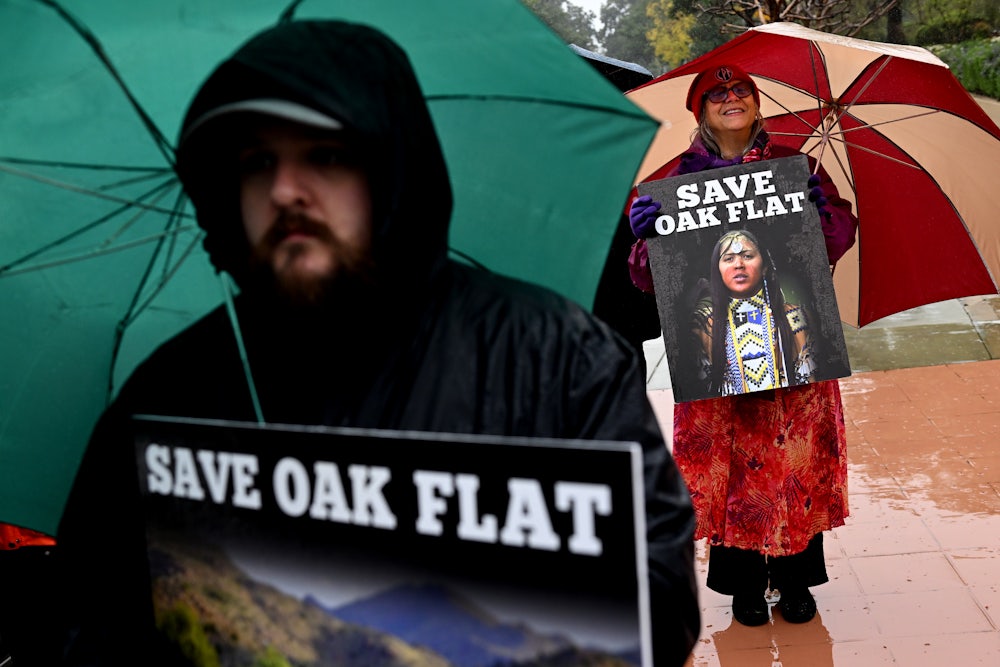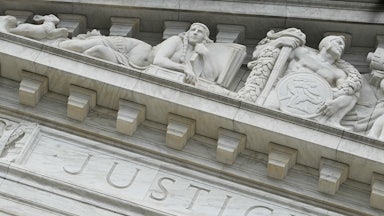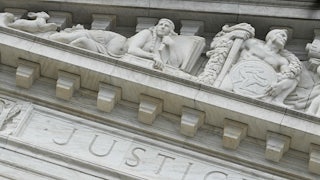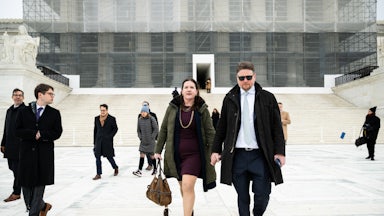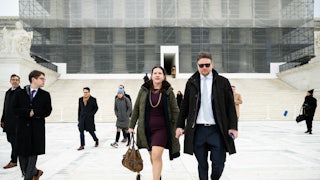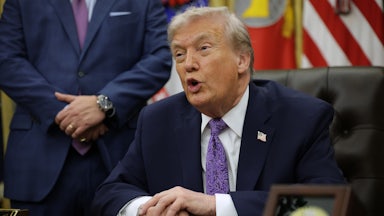The Supreme Court is no stranger to religious freedom cases. Under Chief Justice John Roberts’s tenure, the justices are more sympathetic to such claims than at any other point in the court’s modern history. But one dispute in particular seems to be stuck in the justices’ figurative craw: a land-use battle between a Native American tribe in Arizona, an Australian mining venture, and the federal government.
In Apache Stronghold v. United States, a group of Western Apache tribal members are hoping to stop the U.S. Forest Service from transferring a sacred religious site on federal public lands to a mining company whose methods would effectively destroy their spiritual home. They asked the Supreme Court to intervene last September; the government and the mining company filed their own briefs in October.
Here’s the rub: The court has yet to decide whether it will take up the case. This in and of itself is not necessarily unusual since the justices hear only a fraction of the cases that they are asked to hear. In this case, however, the court’s docket shows that the justices have scheduled it for consideration at their weekly conferences on 15 consecutive occasions. That suggests the court is facing an unusual internal struggle over this high-stakes case.
At issue is the fate of Oak Flat, a swath of high desert and bluffs in central Arizona that is sacred to nearby tribes, including the Western Apache. The land consists of “old-growth oak groves, sacred springs, burial locations, and a singular concentration of archaeological sites” that provide evidence of almost 1,500 years of continuous usage. Apache tradition holds that Oak Flat is the home of Ga’an, spiritual beings that are central to the tribe’s religious belief.
“The Ga’an are ‘our creators, our saints, our saviors, our holy spirits’—‘the very foundation of [Apache] religion,’” the group’s lawyers told the court, quoting from earlier legal filings. “As the dwelling place of the Ga’an, Oak Flat is a direct corridor to the Creator and is ‘uniquely endowed with holiness and medicine.’ Neither ‘the powers resident there, nor [Apache] religious activities that pray to and through these powers can be relocated.’”
Tribal members perform a variety of rituals in Oak Flat that cannot be performed anywhere else, such as prayer rituals, healing ceremonies, and rites of passage. “One example is the Sunrise Ceremony, a multi-day celebration marking an Apache girl’s entry into womanhood,” they told the justices. “To prepare, the girl gathers plants from Oak Flat that contain ‘the spirit of Chi’chil Biłdagoteel.’ As she gathers, she speaks to the spirit of Oak Flat, expressing gratitude for its resources.”
Lying beneath Oak Flat is a resource that is of particular interest to multinational corporations: copper. Geological engineers estimated that the deposit, which was first discovered in 1995, could amount to roughly two billion tons of the metal. Rio Tinto and BHP, two Australian mining companies, formed a joint venture named Resolution Copper shortly after the discovery to acquire the land and extract the copper from it.
After years of wrangling between federal lawmakers and Resolution Copper, Congress approved a land swap in 2014 that would transfer roughly 2,400 acres in and around Oak Flat to the company in exchange for other lands elsewhere. While the law required the mining company to work with the tribes on various access and protection measures, it ultimately envisions the site’s destruction. Extensive excavations will eventually cause Oak Flat’s surface to distort and sink until it forms a “large surface crater,” according to Congress.
After the U.S. Forest Service announced in 2021 that it would complete a key environmental hurdle for the project, Apache Stronghold—a nonprofit group led by members of the San Carlos Apache Tribe—sued the government in federal court to stop it. They invoked federal law, the First Amendment’s free exercise clause, and treaty obligations to argue that permanently destroying their sacred sites would illegally and unconstitutionally infringe upon their religious freedom.
The courts have historically resisted recognizing Native American religious claims over public land. In the 1988 case Lyng v. Northwest Indian Cemetery Protection Association, for example, the Supreme Court ruled against a group of Native American and environmental litigants who argued that a planned logging road—and the logging itself—would unconstitutionally damage a sacred site in northwest California. The justices concluded that the plaintiffs’ plight did not fall under the free exercise clause because there was no coercion, discrimination, or penalty for their religious beliefs. The government, the court wrote, “simply could not operate if it were required to satisfy every citizen’s religious needs and desires.”
The Ninth Circuit Court of Appeals leaned on that ruling and others to reject Apache Stronghold’s claims last year. Its 246-page decision is something of a mess. Since a majority of justices were unable to agree on every aspect (or even most) of the case, it essentially consists of two majority opinions that each deal with half of Apache Stronghold’s claims. One of them dispensed with the group’s constitutional claims by relying heavily upon Lyng.
Apache Stronghold told the justices in their petition that the Ninth Circuit had misapplied the prevailing legal precedents. In the 1990 case Employment Division v. Smith, for example, the high court declined to allow free exercise clause claims against what it described as “neutral laws of general applicability.” That decision prompted a political backlash that led Congress to enact the Religious Freedom Restoration Act, more commonly known as RFRA, in 1993.
Under RFRA, the federal government cannot impose a “substantial burden” on someone’s religious practices unless that burden is the “least restrictive means of furthering a compelling government interest.” In practice, RFRA allows for Americans to claim religious exemptions to various federal laws under certain circumstances. Perhaps the most famous case involving RFRA was the 2014 decision Burwell v. Hobby Lobby, where the high court exempted the Christian craft-supply company from the Affordable Care Act’s contraceptive mandate.
The Ninth Circuit concluded that RFRA had “subsumed” the court’s decision in Lyng instead of “overriding” it. In other words, the judges concluded that RFRA had meant to work in harmony with Lyng instead of superseding it. Apache Stronghold disagreed. It argued that the Supreme Court had previously rejected efforts to draw upon pre-Smith cases when interpreting RFRA and treated the law as a break from the Supreme Court’s approach, not a continuation of it.
Apache Stronghold’s claims have drawn broad support from other religious groups, including a wide range of Arizona and New Mexico religious organizations, as well as the national leaderships of some of the country’s most prominent Christian denominations. “This court has already held that when [the] government controls the resources required for religious practice, barring access to those resources is a substantial burden on free exercise,” one of their briefs argued. “The same must be true for federal lands.”
Top Republican figures have also sided with what they described as an important religious liberty case. Utah Senator Mike Lee, a top Trump ally in the Senate, argued in a friend-of-the-court brief that it was “important to defend the religious liberty of minority faiths and religious communities like Apache Stronghold—because the religious liberties of all rise or fall together.” Oklahoma Attorney General Gentner Drummond also filed a brief alongside three other states urging the court to review the lower court ruling, pointing to different approaches in federal courts in his state.
“The present decision of the Ninth Circuit, however, if left unchecked and uncorrected by this Court, will lead to the harms that Oklahoma has avoided: an imbalance between private religious belief and broad government power, the destruction of sacred places, and the extinguishment of timeless practices without significant scrutiny to ensure that such action is truly necessary,” Drummond argued.
All of which leads to the big question: Why hasn’t the court decided for or against taking the case yet? It’s worth noting that the Supreme Court’s weekly conferences are perhaps its most opaque proceedings. When the justices gather to debate pending petitions and other administrative matters, they do so alone and they generally do not discuss the outcomes. Their semi-weekly orders sheet is the only record of their decisions within, and it almost never reveals vote totals or the court’s reasoning behind an action.
The most likely possibility is that the court has already voted not to hear the Apache Stronghold case and one or more justices are writing a dissenting opinion. The justices’ usual practice is to not announce a decision or outcome until a dissent is ready for publication. (The recent extraordinary order in A.A.R.P. v. Trump, an Alien Enemies Act case, is the exception that proves the rule.) In the next few weeks, the court may announce that it will not hear the case in its weekly orders, complete with a lengthy dissent by Justice Neil Gorsuch or one of his colleagues.
But that outcome is far from certain. Over the last few terms, the Supreme Court kept relisting Hamm v. Smith for more than a year, far longer than the usual repeat flyer at weekly conferences. That case involved a death-row prisoner’s intellectual disability and whether it would preclude his execution. In November, the justices ultimately decided to send it back to the lower courts for reconsideration, writing a short, unsigned opinion that instructed the Eleventh Circuit on the next steps it should take.
Whatever the reason, the court is right to take its time with this particular case. The justices often hear religious freedom cases that involve relatively modest real-world stakes: One recent decision involved a state agency’s refusal to allow a church to participate in a tire-recycling program for playgrounds, for example. If such petty indignities can draw the Supreme Court’s attention, then allowing a foreign mining company to forever despoil and desacralize a Native American spiritual site to create shareholder value should as well.
